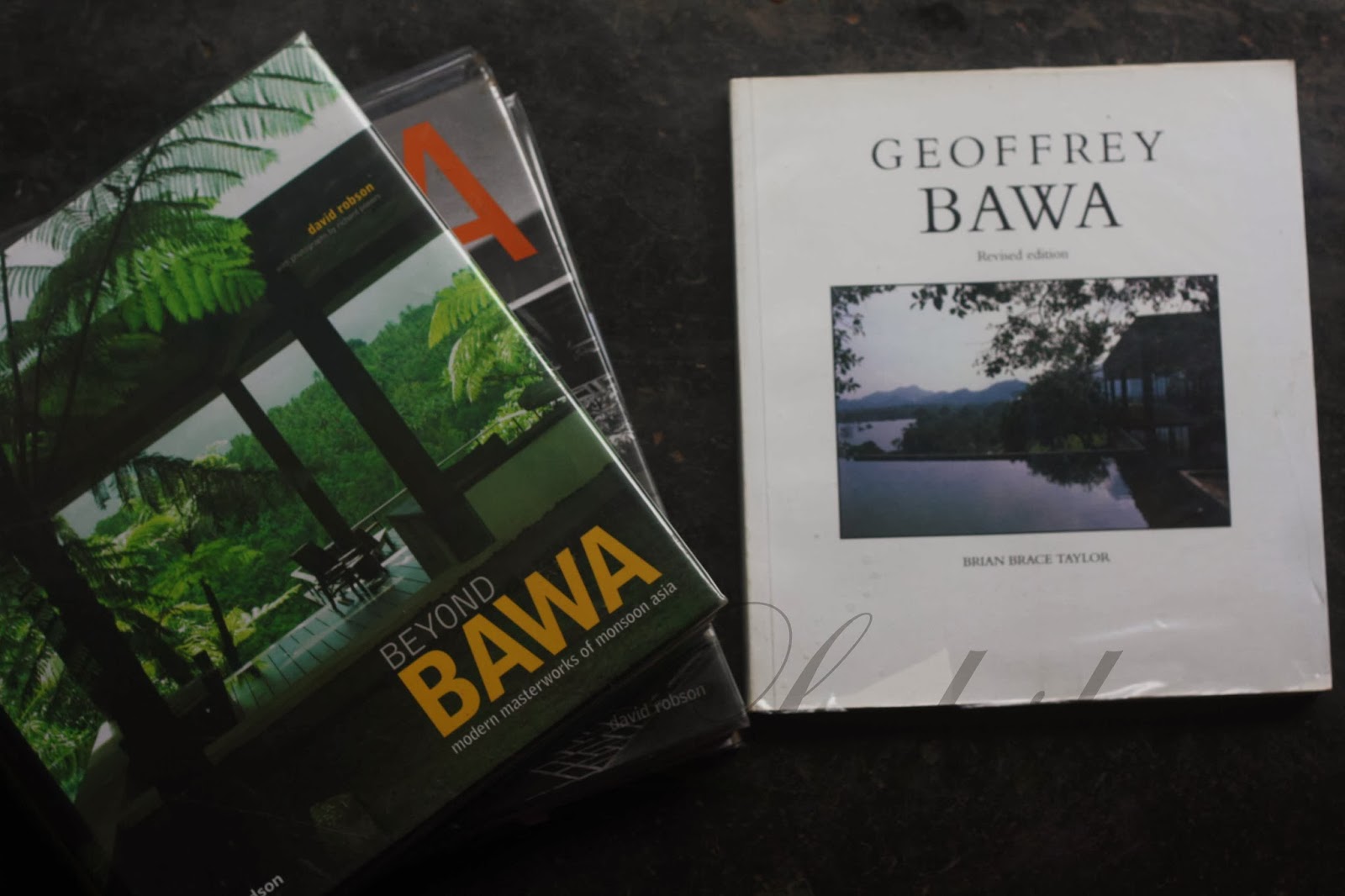How deeply am I in love with "Geoffrey Bawa"the Master Architect who inspires me at every step to deeply love the amazingly built spaces, courtyards, pavilions, verandahs, walls of plastered brick, roofs of half round Portuguese tiles, colums of satin wood, window of timber lattice, floors of rough granite, the open plan and continuous flow of spaces, reflecting pools and the lovely white Frangipanis and light and shade and the special kind of darkness that exudes in all his images photographed!
A Loving Tribute to the great Geoffrey BAwa!
A Loving Tribute to the great Geoffrey BAwa!
Reflecting pools and Frangipani!
 |
| these reflecting pools .... |
His journey in the first few years were like any architect,struggling to find his place among the sea of other architects..finding juniors and personal assistants who left him to finally reach a new generation of young assistants including Channa Daswatte (now a famous architect of SriLanka). After wards Bawa was happy to amuse himself with a succession of projects that kicked off six years of astonishing activity.
All of us remember Bawa for building one of the most Beautiful Asian Gardens of the 20 th century.You could all imagine how much he loved this space he built from scratch and spent almost fifty years in beautifying Lunuganga! Lunuganga has been featured inside out in various Magazines and various other sites. It was here that he experimented with interplay between building and landscape, between inside and outside space.In the early 1960s, he bought a row of tiny bungalows off Colombo’s Bagatelle Road and embarked on a process that would transform them into a labyrinth of courtyards and verandas topped by a white Corbusian tower. This space also served as his space laboratory where he experimented with architectural scenography and the effects of light and shade.
A.S.H. de Silva house in Galle, the Raffel House in Ward Place, the Bandaranaike House at Horagolla and in Colombo the de Soysa House and the Jayakoddy House ,Bentota Hotel ,Srilankan Parliament are the rememberances of his architectural marvel.His designs varied from the series of pavilions and courtyards,with subsidiary courtyards within living spaces to tower designs to roof houses where he dispensed with walls and asserted the primacy of roofs in tropical countries.
His design strategy set in motion a lifestyle revolution which later spread across Tropical Asia. Bawa drew inspiration both from 20th C. Modernism and from Sri Lankan tradition(those Kandyan Manor Houses) and encouraged people to value their own past. But it is a sad thing to say that he has never been fully acknowledged in his native state.
In the year 1970,He came to India to set up our own "MAdurai Club" In MAdurai..and the Connemara hotel in South India.
There isn't much I could say ,cause these ideas were all heard and read and byhearted in the mind and then I couldn't Conclude this topic by taking these golden words from the great architect David Robson who has researched and studied on Geoffrey Bawa..These words were written for an article for Arch Daily on "Remembering Bawa"
Bawa’s Qualities by David Robson
Bawa enjoyed a unique view of the post-colonial world: he was half Asian and half European and his life spanned the divide between colonial Ceylon and independent Sri Lanka. He was an addicted traveller who filled his mind with a rich store of architectural images and he delved into the whole history of architecture. But he also explored the architectural traditions of his native Sri Lanka and was able to fuse elements from widely different sources to create new ideas.
He was an intuitive designer with a strong spatial sense and could conjure up fully fledged ideas in his head. These often developed as scenographic journeys, rather like story-boards for a film. He had come to architecture from an interest in garden making and conceived of buildings as elements in a landscape, seeking always to break down the barriers between inside and outside space.
Although he was no great draftsman, he produced endless sketches of plans and sections in order to convey his ideas to his colleagues. He recognized his own short-comings and surrounded himself with people who were good at doing those things which he was unable to do himself. With them he acted as an impresario, the conductor of an orchestra, an incisive judge, an arbiter of taste, an uncompromising critic: they enabled him to achieve things that he could never have achieved by himself whilst he inspired them to achieve more than they had ever dreamed of.
The Architectural Association in London introduced him to modernist ideology, but his earlier training as a lawyer had bred in him a health disregard for cant. Although he adopted a modernist approach in his early work he soon realised that white cubist architecture was unsuited to the humid tropics and shifted towards a regionalist position, borrowing from vernacular forms and adopting local materials and technologies. Coming at a time of economic restraint and import restrictions this shift produced a way of building which was efficient, inexpensive and appropriate to climate and culture.
Bawa was driven by pragmatic considerations: local materials were cheap and readily available; traditional forms had been developed to function optimally in the tropical climate. He avoided using large areas of glass or air-conditioners because these were expensive and increased energy consumption. His buildings were naturally cool and comfortable and, long before the terms had been coined, were sustainable, energy conscious and ecologically friendly.
He was also driven by aesthetic considerations and strove to create buildings which were contemporary in spirit and yet rooted in tradition. He derived enormous pleasure from making buildings, particularly if they gave pleasure to others, and it was no surprise that he was singled out by philosopher Alain de Botton in his book ‘The Architecture of Happiness’.
In the final analysis David Robson says that Bawa bequeathed a new but timeless way of building to his native Sri Lanka just as it was emerging from four centuries of colonial hegemony.
 |
| Ena de Silva house |
 |
| Bentota hotel courtyard |
 |
| Lunuganga |
.jpg) |
| Lunuganga |
 |
| hotel lobby |
 |
| Bentota hotel |
 |
| Ena de Silva |
 |
| Polongotowa residence |
 |
| ena de silva house |
 |
| Srilankan parliament |
 |
| Bawas residence |
 |
| Lunuganga |
 |
| MAdurai club |
 |
| MAdurai Club |














































